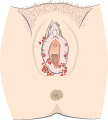Vulval Symptoms
The most common vulval symptoms are pruritus (itching), soreness, burning and superficial dyspareunia (pain on sexual penetration). Symptoms can be due to local problems including infection, dermatological disease, malignant and premalignant disease, and the vulval pain syndromes. Skin disease affects the vulva, but rarely in isolation. Systemic disease may predispose to certain vulval conditions (e.g. candidiasis with diabetes mellitus).
Causes of Pruritus Vulvae
Infections:
Candidiasis (± vaginal discharge)
Vulval warts (condylomata acuminata)
Pubic lice, scabies
Dermatological disease:
Any condition, especially eczema, psoriasis, lichen simplex, lichen sclerosus, lichen planus, contact dermatitis
Neoplasia:
Carcinoma
Premalignant disease (vulval intraepithelial neoplasia, VIN) [→ p.51]
Miscellaneous Benign Disorders of the Vulva and Vagina
Lichen Simplex (or Chronic Vulval Dermatitis) (Fig. 6.2 )
Women with sensitive skin, dermatitis or eczema can present with vulval symptoms, which can result in lichen simplex, a chronic inflammatory skin condition. This presents with severe intractable pruritis, especially at night. The area, typically the labia majora, is inflamed and thickened with hyper- and hypopigmentation. The symptoms can be exacerbated by chemical or contact dermatitis and are sometimes linked to stress or low body iron stores. Vulval biopsy is indicated if the diagnosis is in doubt. Irritants such as soap should be avoided; emollients, moderately potent steroid creams and antihistamines are used with the aim of breaking the itch–scratch cycle.
Fig. 6.2 Lichen simplex.

Lichen Planus
A common disease which may affect skin anywhere on the body, but particularly mucosal surfaces such as in the mouth and genital region. Lichen planus presents with flat, papular, purplish lesions. In the mouth and genital region it can be erosive and is more commonly associated with pain than with pruritis. The aetiology is unknown but may be autoimmune related. It can affect all ages and is not linked to hormonal status. Treatment is with high-potency steroid creams; surgery should be avoided.
Lichen Sclerosus
The vulval epithelium is thin with loss of collagen. This may have an autoimmune basis and thyroid disease and vitiligo may coexist. Around 40% of women have or go on to develop another autoimmune condition. The typical patient is postmenopausal but much younger women are occasionally affected. It causes severe pruritis, which may be worse at night. Uncontrollable scratching may cause trauma with bleeding and skin splitting and symptoms of discomfort, pain and dyspareunia. The appearance is of pink–white papules, which coalesce to form parchment-like skin with fissures. Inflammatory adhesions can form potentially causing fusion of the labia and narrowing of the introitus. Vulval carcinoma can develop in 5% of cases. Biopsy is important to exclude carcinoma and to confirm the diagnosis. Treatment is with ultra-potent topical steroids.
Vulvar Dysaesthesia (Vulvodynia) or the Vulval Pain Syndromes
These are diagnoses of exclusion, with no evidence of organic vulval disease. They are divided into provoked or spontaneous vulvar dysaesthesia and subdivided according to site: local (e.g. vestibular) or generalized. They are associated with many factors including a history of genital tract infections, former use of oral contraceptives and psychosexual disorders. Spontaneous generalized vulvar dysaesthesia (formerly essential vulvodynia) describes a burning pain that is more common in older patients. Vulvar dysaesthesia of the vestibule causes superficial dyspareunia or pain using tampons and is more common in younger women, in whom introital damage must be excluded. For both conditions, topical agents are seldom helpful and oral drugs such as amitriptyline or gabapentin are sometimes used.
Infections of the Vulva and Vestibule
Herpes simplex, vulval warts (condylomata acuminata) (Fig. 6.3), syphilis and donovanosis may all affect the vulva [→ p.75].
Fig. 6.3 Extensive vulval warts.

Candidiasis may affect the vulva if there has been prolonged exposure to moisture. Candidiasis is more common in diabetics, the obese, in pregnancy, when antibiotics have been used or when immunity is compromised, and tends to present with irritation and soreness of the vulva and anus rather than discharge. Prolonged topical or oral antifungal therapy may be necessary.
Bartholin’s Gland Cyst and Abscess
The two glands behind the labia minora secrete lubricating mucus for coitus. Blockage of the duct causes cyst formation. If infection occurs, commonly with Staphylococcus
Stay updated, free articles. Join our Telegram channel

Full access? Get Clinical Tree


